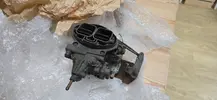Steve Swan
Well-Known Member
OK here goes. I think bending the mounting anti clockwise to make the crank a little more vertical, then you will have to tweak the carb end of the lever clockwise to stop the ball joint locking on travel. Make sure the cable has the absolute minimum of free play, as it hardly moves and any looseness there is multiplied by nearly 3 at the pedal or carb.
Also there must be no freeplay in the axle mounting/clock spring affair at the crank.
You'll see from my poor sketch above that the pedal travel is fair, but the cable only moves a third of that distance and has to be stepped up at the engine end again, freeplay in the centre spells Disaster.
It is important to have the lower (throttle cable) connection working in the 25 past, to 25 to, part of its arc. All linkages are bound by this. I always liken it to the clock face Max L-R travel is given by being at the 5 to, to 5 past, or 25 past to 25 to. For Max up and down travel then its 10 past to 20 past, or 20 to, to 10 to.
Then you need to look at the direction the linkage pulls in, in the same way. Looking at the pic above you are pulling from Quarter to to 20 to. I think it would be better being in the range 20 to, to 25 to.
If you have deciphered my ramblings you will see that at half travel the linkages should be tangential to each other, pretty much 90 degrees or 12,3,6 and 9 on the Clock face. I always like to visualise stuff.
If this will not work you could go to a cam drum type linkage on the carb spindle. If you imagine a Cam lobe on the end of the spindle with the tip of the lobe at 5 past position with a short cable to the crank. The cable is attached at the 4 position on the clock face and the cable goes over the top of the lobe to the crank arm This means when travelled the throttle is slow to act as it has a longer lever (the cam lobe) but as it rotates the effective throttle lever gets shorter and faster acting. meaning you have good control on the first third of throttle and snap acting on the last third.
Sorry if it doesn't seem to make much sense, if you were local I could just pay a visit and draw on your garage wall. Paul Errington drove himself up the wall with this too.
If it makes you feel better being able to visualise and correct this on the Engines valvetrain (which is bound by the same laws of Physics Captain) is also important to finding the last drop of power, and I'm sure I'm not quite there yet.
Best
S
Also there must be no freeplay in the axle mounting/clock spring affair at the crank.
You'll see from my poor sketch above that the pedal travel is fair, but the cable only moves a third of that distance and has to be stepped up at the engine end again, freeplay in the centre spells Disaster.
It is important to have the lower (throttle cable) connection working in the 25 past, to 25 to, part of its arc. All linkages are bound by this. I always liken it to the clock face Max L-R travel is given by being at the 5 to, to 5 past, or 25 past to 25 to. For Max up and down travel then its 10 past to 20 past, or 20 to, to 10 to.
Then you need to look at the direction the linkage pulls in, in the same way. Looking at the pic above you are pulling from Quarter to to 20 to. I think it would be better being in the range 20 to, to 25 to.
If you have deciphered my ramblings you will see that at half travel the linkages should be tangential to each other, pretty much 90 degrees or 12,3,6 and 9 on the Clock face. I always like to visualise stuff.
If this will not work you could go to a cam drum type linkage on the carb spindle. If you imagine a Cam lobe on the end of the spindle with the tip of the lobe at 5 past position with a short cable to the crank. The cable is attached at the 4 position on the clock face and the cable goes over the top of the lobe to the crank arm This means when travelled the throttle is slow to act as it has a longer lever (the cam lobe) but as it rotates the effective throttle lever gets shorter and faster acting. meaning you have good control on the first third of throttle and snap acting on the last third.
Sorry if it doesn't seem to make much sense, if you were local I could just pay a visit and draw on your garage wall. Paul Errington drove himself up the wall with this too.
If it makes you feel better being able to visualise and correct this on the Engines valvetrain (which is bound by the same laws of Physics Captain) is also important to finding the last drop of power, and I'm sure I'm not quite there yet.
Best
S


![20241115_161225(0)[1].webp 20241115_161225(0)[1].webp](https://turborenault.co.uk/data/attachments/220/220881-1b3fbea11d41692181480cb73635cbb0.jpg?hash=d7mAjfM8aU)













